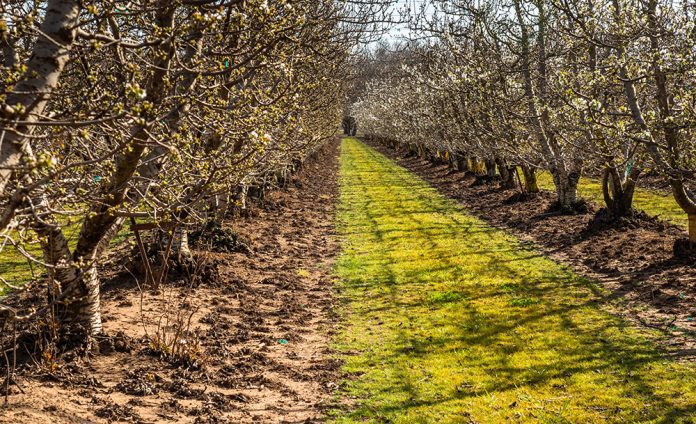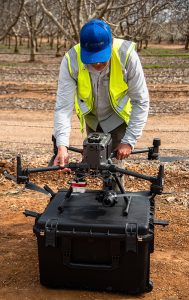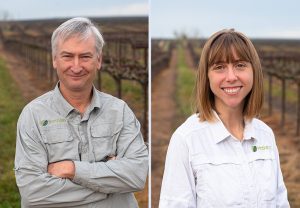
A California company is incorporating a unique cover crop mix with the hope of increasing permanent soil carbon sequestration in orchards and monetizing the land.
The cover crop mix, known as Oakville bluegrass, caught the attention of Vitidore’s founders as a new perennial solution that complements farm schedules and does not impede productivity in specialty crop systems.
One of the company’s founders and Vice President of Solutions John Knutson said he first came across the mix during his previous career in turfgrass sales. The bulbosa grass cultivar (under license from Radix Evergreen) was originally created for use on golf courses, but due to the grass’ unique dormancy cycle in which it consumes no water as well as other benefits, Knutson began to consider its use in agricultural crops such as wine grapes.
“I specifically thought so because this grass has a dormancy cycle that begins in April and ends in October, and that is almost directly opposite of bermudagrass,” he said. “I thought that might be interesting because grapevines are deciduous, losing the bulk of their leaves in November but really stopping growing about middle of October, and then they break their dormancy cycle around the third week of March.
“That might line up perfectly in a symbiotic relationship with this [cover crop] species in that it could survive on natural precipitation and then go dormant when the vines are starting to wake up.”
The cover crop mix also has applications in tree nut orchards and is being tested in UCCE projects, according to Knutson and co-founder/President Alyssa DeVincentis.
Environmentally and Economically Friendly
Oakville bluegrass is a winter cover crop and is meant to be mowed down right before many permanent crops’ growth periods start around March.
“What makes this grass unique is the dormancy cycle… and the growth habits; it’s a very low-statured grass away from the cash crop,” DeVincentis said. “It’s not going to be affecting the agronomic performance of the cash crop.”
The cover crop not only has agronomic benefits but also economic benefits, DeVincentis said. “On the very tangible side of things, you have reductions in chemical and labor costs,” she said, noting that permanent cover reduces the need for activities like mowing and frost protection. “Those can be really, really expensive.”
The indirect benefits of permanent cover like Oakville bluegrass are more intangible. “In addition to improving air quality and putting less pressure on scarce environmental resources like water, there’s an understanding that it’s good for the environment, it’s good for the planet to increase your soil carbon content and replace stores of carbon that have been diminished over time,” DeVincentis said.
Telling a grower how much carbon is sequestered in their ground and what that value is can be impactful. “That grower can take that information and keep it on their balance sheet and perhaps market their crop as climate-smart because it is from a farm that’s managing their carbon, that knows how much is in the ground.”

Platform Helps Realize Soil Carbon
The company has developed a software platform, engineered by Principal Data Scientist Hervé Guillon, to accompany the land monetization and tracking of environmental benefits from Oakville bluegrass. “It’s a really important part of what we’re trying to do,” Knutson said.
The software works as an improvement on the traditional way of verifying soil carbon content, which Knutson said involves digging a hole in the ground, putting the excavated soil into a bag and sending it off to a lab for testing. The platform, rather, helps to not only aggregate these data onsite, but also understand the change in sequestered carbon from Oakville bluegrass and other sustainable practices and predict future changes. Then, according to Guillon, it uses cloud-based machine learning and artificial intelligence approaches to extrapolate the signal from ground-truth samples to any location of interest.
“Traditional collection methods… would be unable to robustly infer information about new, unseen locations, or locations with under-studied practices and changing processes or conditions,” Guillon said. “The ability to adapt, scale and predict at a new location is the key advantage of using machine learning and artificial intelligence with spatially available datasets like remote sensing (satellite imagery, drone imagery) or meteorological data.”
The platform also doesn’t just analyze Oakville bluegrass’ effect on sequestered carbon in the soil; it works with any cover crop mix, annual or perennial. “We like to call it agnostic to the intervention,” Knutson said.

Addressing Common Concerns
Some across the agriculture industry have voiced concerns over the years about cover crops, especially permanent mixes, affecting on-farm activities such as harvest. DeVincentis said this was the one of the company’s biggest questions at the start when implementing Oakville bluegrass, but noted that, while anecdotal, across 250-plus acres of various permanent crops, growers have seen no issues with harvest.
Even tree nut acreage, including almonds, walnuts and pistachios, that the mix is planted in hasn’t seen any noticeable impacts at harvest.
“This is throwing that concept on its head,” she said, noting that the question of whether there is an impact at harvest is still crop-specific.
“It’s really all about the grass’ dormancy and its stature,” she said. “It’s so low and dense to the ground, most of the biomass growth is actually happening belowground; so, we haven’t seen it interfere with harvest.
“It goes to sleep at the right time of the year so it’s inherently out of the way of the cash crop. It’s not competing for any resources.”
Co-op Expansion
In early 2022, Vitidore decided to expand the company beyond the technology platform and implement a grower-led, non-profit co-op that acts as a buyer group for Oakville bluegrass. Research projects the company is a part of with UCCE and other entities have been chiefly informed by the company’s interests, but moving forward, the hope is for future projects to specifically reflect the interests of growers in the co-op.
“We want this to be a completely specialty crop grower-led operation where we are the service provider,” DeVincentis said. “…they get access to all the information we’ve developed over the past three years.”
Knutson and DeVincentis encourage any prospective growers looking to have their voices heard as part of the co-op’s sustainability push to reach out to Vitidore.
“It’s a very exciting time to be a part of this,” DeVincentis said.










